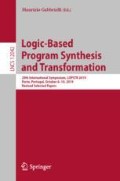Abstract
Proximity relations are binary fuzzy relations that satisfy reflexivity and symmetry properties, but are not transitive. They induce the notion of distance between function symbols, which is further extended to terms. Given two terms, we aim at bringing them “sufficiently close” to each other, by finding an appropriate substitution. We impose no extra restrictions on proximity relations, allowing a term in unification to be close to two terms that themselves are not close to each other. Our unification algorithm works in two phases: first reducing the equation solving problem to constraints over sets of function symbols, and then solving the obtained constraints. Termination, soundness and completeness of both algorithms are shown. The unification problem has finite minimal complete set of unifiers.
Supported by Austrian Science Fund (FWF) under project 28789-N32 and by the strategic program “Innovatives OÖ 2020” by the Upper Austrian Government.
Access this chapter
Tax calculation will be finalised at checkout
Purchases are for personal use only
References
Aït-Kaci, H., Pasi, G.: Fuzzy unification and generalization of first-order terms over similar signatures. In: Fioravanti, F., Gallagher, J.P. (eds.) LOPSTR 2017. LNCS, vol. 10855, pp. 218–234. Springer, Cham (2018). https://doi.org/10.1007/978-3-319-94460-9_13
Dubois, D., Prade, H.: Fuzzy Sets and Systems: Theory and Applications. Mathematics in Science and Engineering, vol. 144. Academic Press, Cambridge (1980)
Formato, F., Gerla, G., Sessa, M.I.: Extension of logic programming by similarity. In: Meo, M.C., Ferro, M.V. (eds.) 1999 Joint Conference on Declarative Programming, AGP 1999, L’Aquila, Italy, 6–9 September 1999, pp. 397–410 (1999)
Formato, F., Gerla, G., Sessa, M.I.: Similarity-based unification. Fundam. Inform. 41(4), 393–414 (2000)
Julián-Iranzo, P., Rubio-Manzano, C.: Proximity-based unification theory. Fuzzy Sets Syst. 262, 21–43 (2015)
Kutsia, T.: Unification with sequence variables and flexible arity symbols and its extension with pattern-terms. In: Calmet, J., Benhamou, B., Caprotti, O., Henocque, L., Sorge, V. (eds.) AISC/Calculemus -2002. LNCS (LNAI), vol. 2385, pp. 290–304. Springer, Heidelberg (2002). https://doi.org/10.1007/3-540-45470-5_26
Kutsia, T., Pau, C.: Proximity-based generalization. In: Ayala Rincón, M., Balbiani, P. (eds.) Proceedings of the 32nd International Workshop on Unification, UNIF 2018 (2018)
Kutsia, T., Pau, C.: Computing all maximal clique partitions in a graph. RISC Report 19–04, RISC, Johannes Kepler University Linz (2019)
Kutsia, T., Pau, C.: Solving proximity constraints. RISC Report 19–06, RISC, Johannes Kepler University Linz (2019)
Rodríguez-Artalejo, M., Romero-Díaz, C.A.: A declarative semantics for CLP with qualification and proximity. TPLP 10(4–6), 627–642 (2010)
Sessa, M.I.: Approximate reasoning by similarity-based SLD resolution. Theor. Comput. Sci. 275(1–2), 389–426 (2002)
Author information
Authors and Affiliations
Corresponding author
Editor information
Editors and Affiliations
Rights and permissions
Copyright information
© 2020 Springer Nature Switzerland AG
About this paper
Cite this paper
Kutsia, T., Pau, C. (2020). Solving Proximity Constraints. In: Gabbrielli, M. (eds) Logic-Based Program Synthesis and Transformation. LOPSTR 2019. Lecture Notes in Computer Science(), vol 12042. Springer, Cham. https://doi.org/10.1007/978-3-030-45260-5_7
Download citation
DOI: https://doi.org/10.1007/978-3-030-45260-5_7
Published:
Publisher Name: Springer, Cham
Print ISBN: 978-3-030-45259-9
Online ISBN: 978-3-030-45260-5
eBook Packages: Computer ScienceComputer Science (R0)

